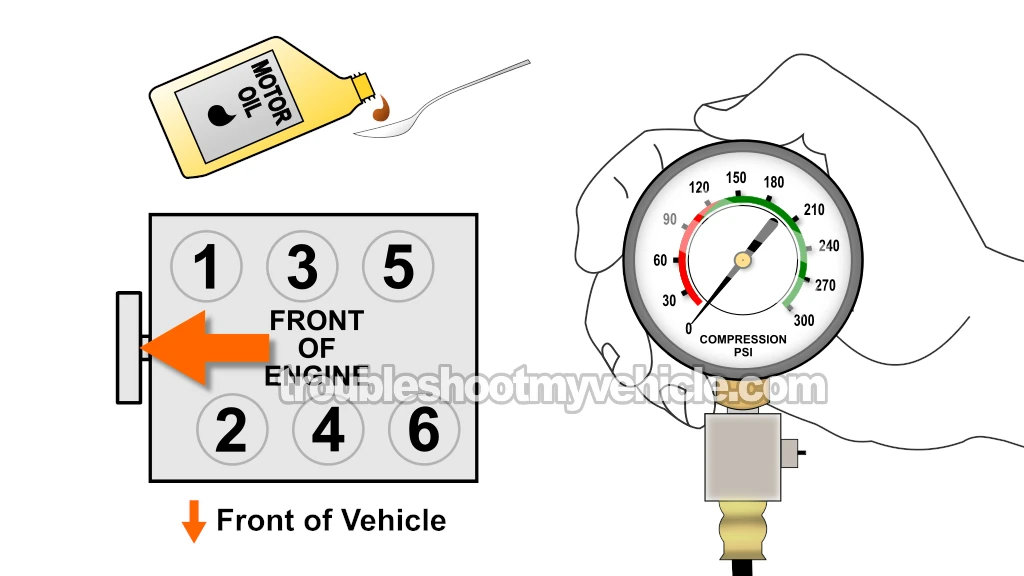Interpreting Your Compression Test Results
As your Toyota's engine accumulates wear and tear, the compression of each cylinder will differ because they may wear out at different rates.
This means the compression values you obtained from all six cylinders in TEST 1 could vary slightly or significantly.
If the difference between these values is small, it won't affect engine performance. However, if the difference is too large, it can cause a rough idle or a misfire condition.
To determine whether the lower compression value is a problem, check if it's more than 15% lower than the highest compression value recorded.
You can calculate this 15% threshold in one of two ways: either manually with pen and paper or by using my low compression calculator. You can access the low compression calculator here: Online Low Engine Compression Calculator (at: easyautodiagnostics.com).
If you want to manually calculate the 15% difference, here's what you'll need to do:
- STEP 1: Multiply the highest compression value by 0.15 (this is the decimal value of 15%).
- STEP 2: Round the result to the nearest one (for example: 25.6 would become 26).
- STEP 3: Subtract the result (the number that was rounded) from the highest compression value.
- ANSWER: The result of this subtraction is the lowest possible compression value any cylinder can have.
Now, let me give you a more specific example: Let's say that I got the following compression readings:
| Cylinder | Pressure |
|---|---|
| #1 | 165 PSI |
| #2 | 95 PSI |
| #3 | 155 PSI |
| #4 | 175 PSI |
My next step is to do the following calculation:
- STEP 1: 175 x 0.15 = 26.25.
- STEP 2: 26.25 = 26 (rounded to nearest one).
- STEP 3: 175 - 26 = 149.
- ANSWER: 149 PSI. Any cylinder with this compression (or lower) value will misfire.
Since cylinder #2 is only producing 95 PSI, I can now conclude that it's 'dead' and causing a misfire.
To find out if the lowest compression value you got from your engine compression test is within a good range, you'll need to do the same calculation. Of course, you'll need to use the highest compression value you got and not the one in the example.
Once you've found the 'dead' cylinder, the next step is to find out what's causing the low compression value. For this step, go to: TEST 2: Wet Engine Compression Test.
TEST 2: Wet Compression Test

If, during TEST 1, you discovered one or more cylinders with a compression value that's more than 15% lower than the highest recorded value, the next step is to determine whether this is caused by significant wear or damage to the cylinder head valves or piston rings.
You can do this by performing a 'wet' compression test. This test involves adding a small amount of oil to the affected cylinder and retesting its compression.
If the low (or O PSI) compression issue is due to worn piston rings, the compression value will increase with the oil added.
However, if the cylinder compression problem lies with the cylinder head valves, the compression value will remain unchanged.
These are the test steps:
- 1
Add a tablespoon (or two) of engine oil in the cylinder you need to retest.
I suggest using a small and long funnel so that the oil will reach the inside of the cylinder. - 2
Once you've added the oil, install the compression gauge, and as before just hand tighten it.
- 3
Have your helper crank the engine till the needle stops climbing on the compression gauge.
- 4
You'll see one of two results:
A.) The needle will climb higher than the previous compression number you recorded for this specific cylinder.
B.) The needle will not move at all or stay at the same number you recorded earlier.
What ever value your compression tester reads, write it down again. - 5
If you have another cylinder that needs to be tested, then repeat steps 1 thru' 4 on it now.
Let's take a look at what test results mean:
CASE 1: The compression value went up after adding motor oil and retesting. This means the low compression issue is caused by worn piston rings.
Here's why: The motor oil you added helped the piston rings form a tighter seal. With this improved seal, the compression inside the cylinder increased, which is reflected in the higher reading on your compression tester. This result only occurs when the problem is due to worn piston rings.
CASE 2: The compression value DID NOT go up after adding oil and retesting (in other words, it stayed the same). This indicates that the low compression in this cylinder, as shown in the dry test, is caused by worn or damaged cylinder head valves.
Precautions To Take When Removing The Intake Manifold Plenum
The thing that complicates doing a compression test on your Toyota's V6 engine, is the fact that the upper intake manifold plenum must be removed.
Here a couple of important suggestions that will help you avoid head-ache inducing complications:
- Begin with a cold engine: Ensure the engine is completely cool before starting to work, as hot engine components can cause burns.
- Place bolts, nuts, and parts away from the engine compartment: Keep removed bolts, nuts, and other parts in a secure location, away from the engine. This prevents them from falling into open intake ports during the procedure.
- Protect intake ports when not testing: Before beginning the compression test, cover open intake ports temporarily with a clean shop towel to prevent debris or contaminants from entering, but remove it before cranking the engine.
- Do not cover intake runners during compression testing: Do not place a shop towel on the open intake runners while performing the compression test. The towel will get sucked into the cylinder when the engine cranks.
- Use new gaskets when re-installing the plenum: Always use new intake manifold plenum and throttle body gaskets to ensure a proper seal and prevent vacuum leaks.
- Install the plenum gaskets dry: Do not apply RTV silicone or any sealant to the intake manifold plenum or throttle body gaskets during installation. These gaskets are designed to seal properly when installed dry.
- Torque bolts to specification: Torque the intake manifold plenum and throttle body bolts and nuts to the appropriate specification during reassembly.
- Ensure safe compression testing: When performing the compression test:
- Disable the ignition system to prevent it from firing spark.
- Disable the fuel system to prevent fuel from entering the cylinders.
- Ensure all removed components are secured and clear of the open intake runners during testing.
More 3.0L Toyota Camry Tutorials
You can find a complete list of 3.0L Toyota Camry tutorials in this index:
Here's a sample of the tutorials you'll find there:
- How To Test For A Blown Head Gasket (1992-2006 3.0L V6 Toyota Camry).
- How To Test The TPS (1997-2001 3.0L V6 Toyota Camry).
- How To Test The MAF Sensor (1997-2001 3.0L V6 Toyota Camry).
- How To Test The Alternator (1997-2001 3.0L V6 Toyota Camry).

If this info saved the day, buy me a beer!


